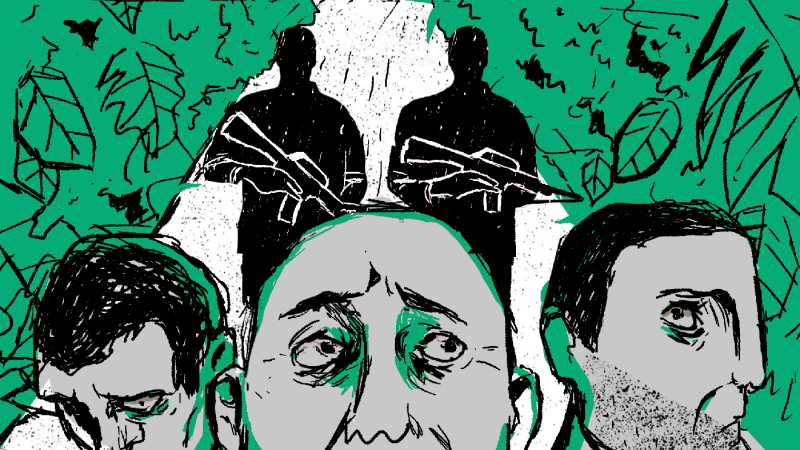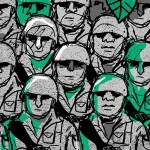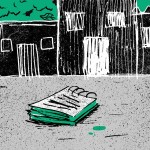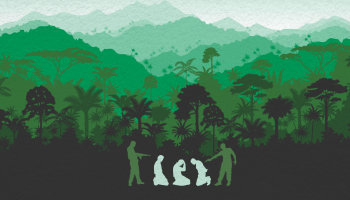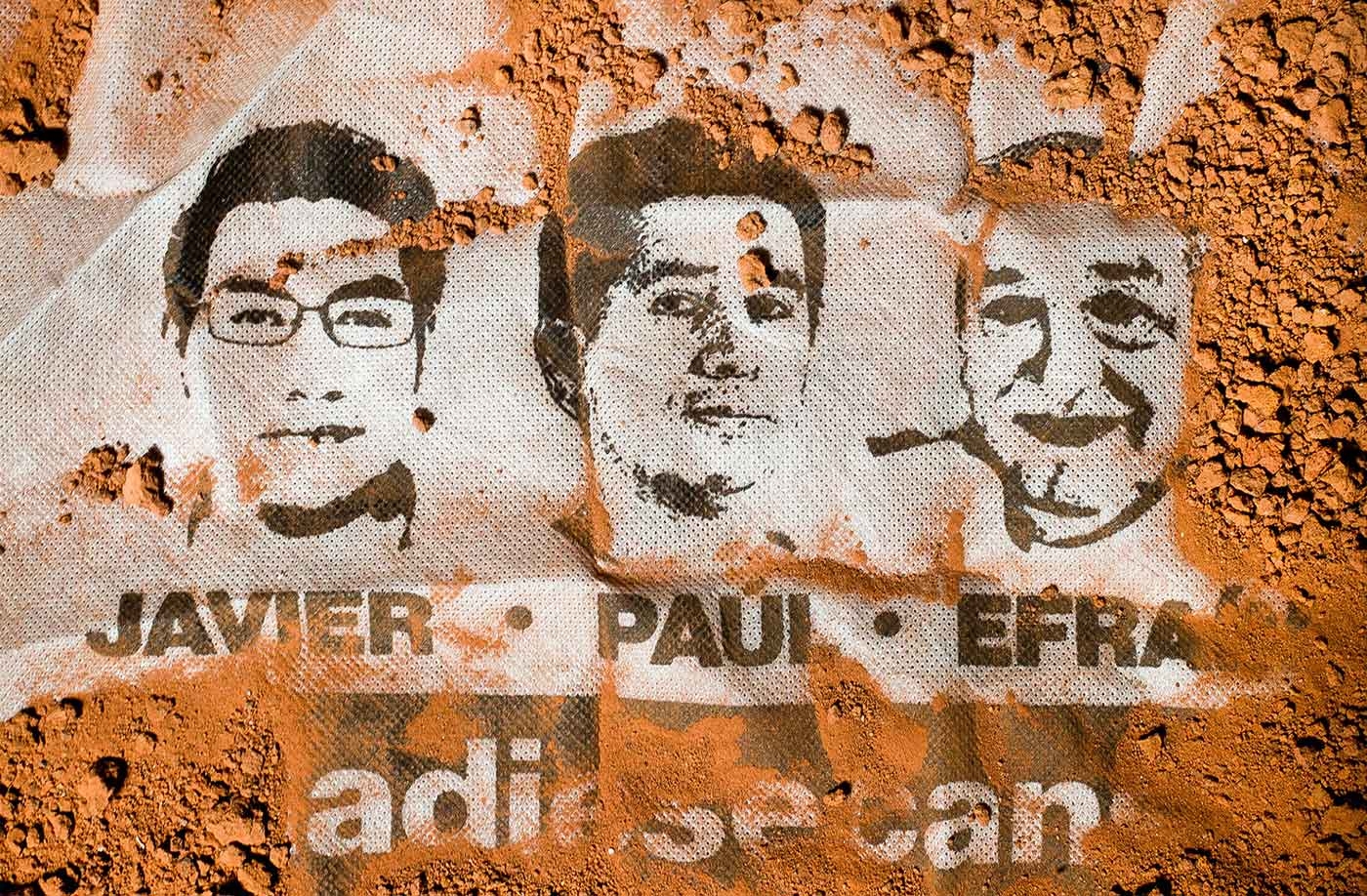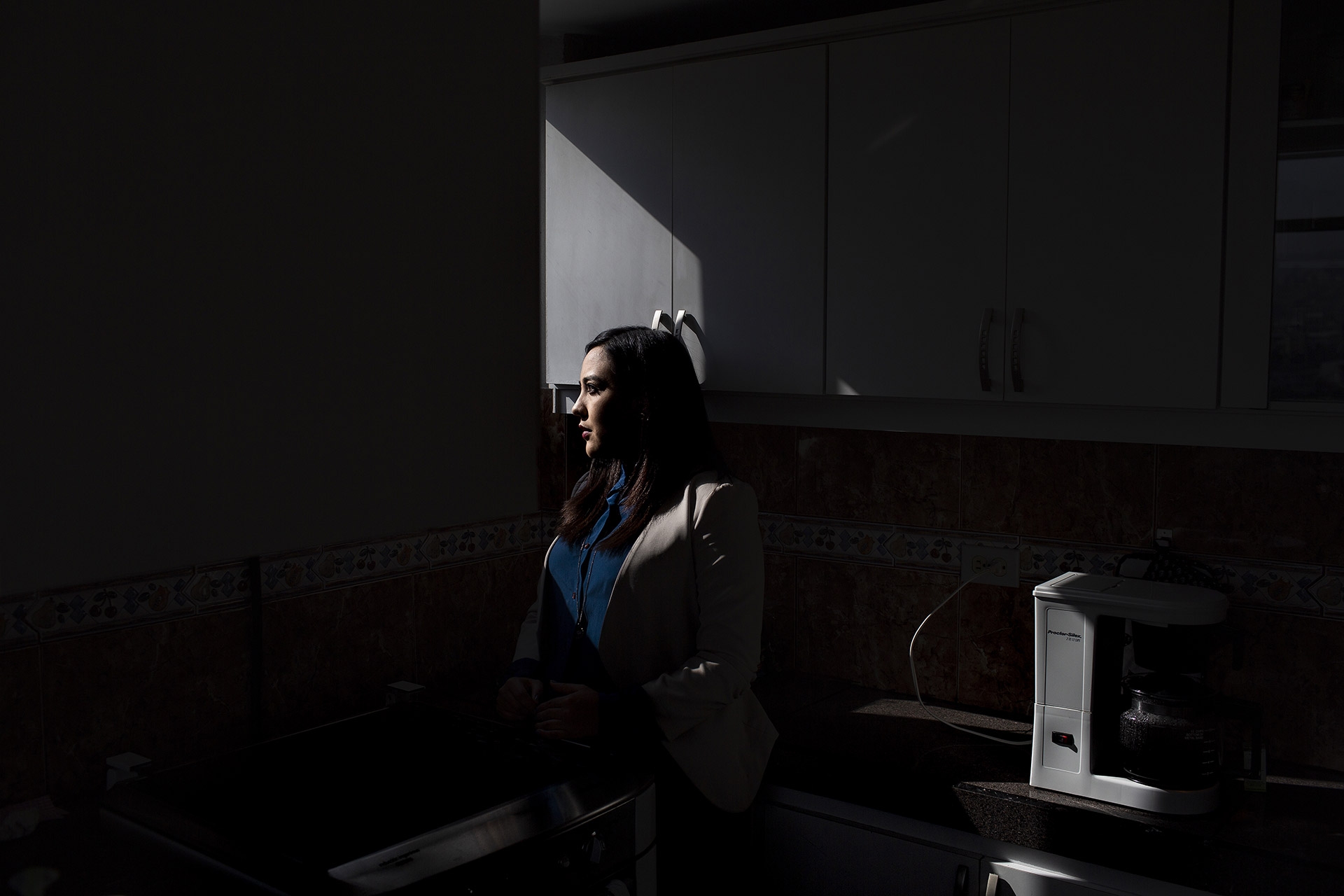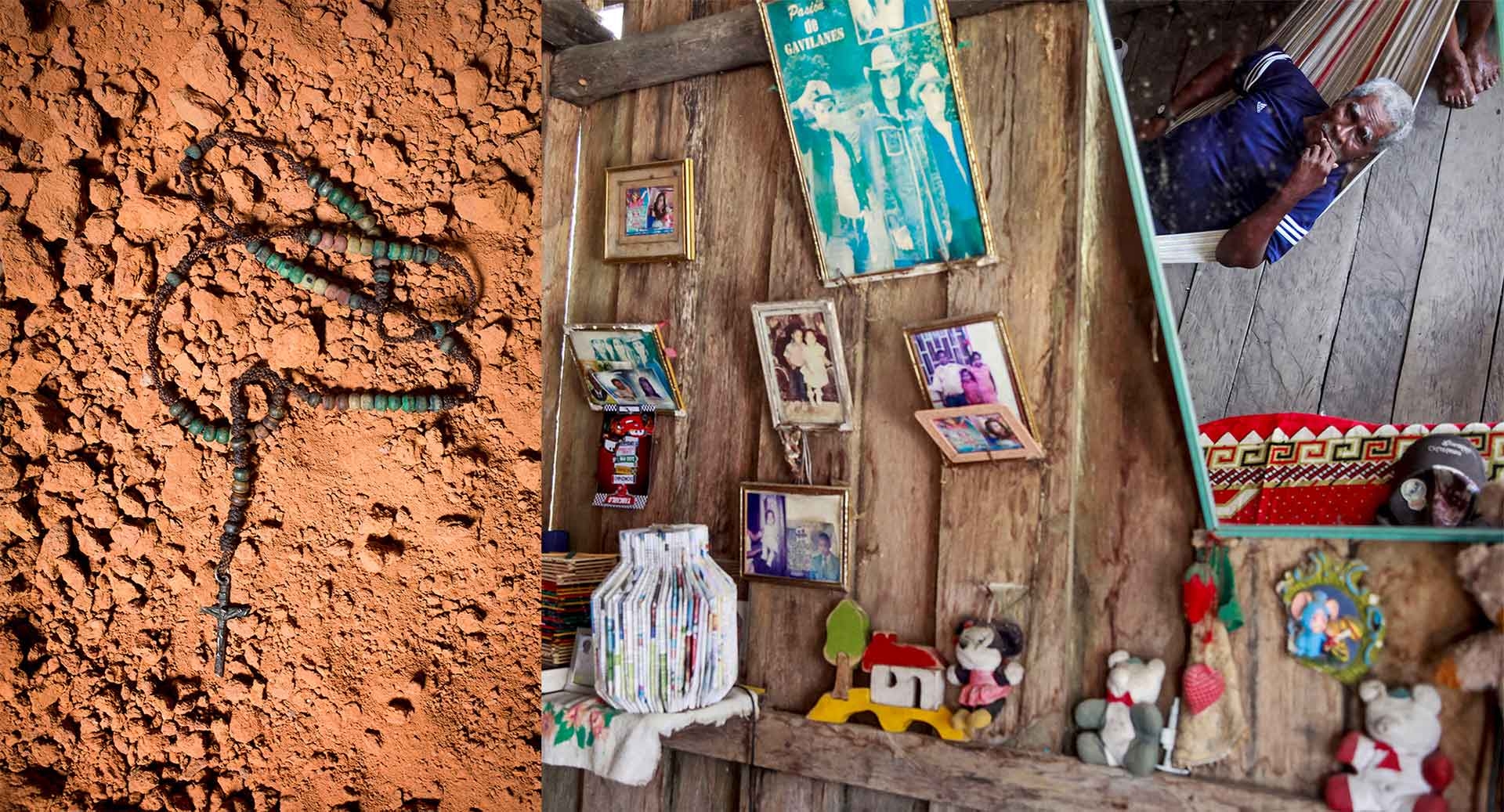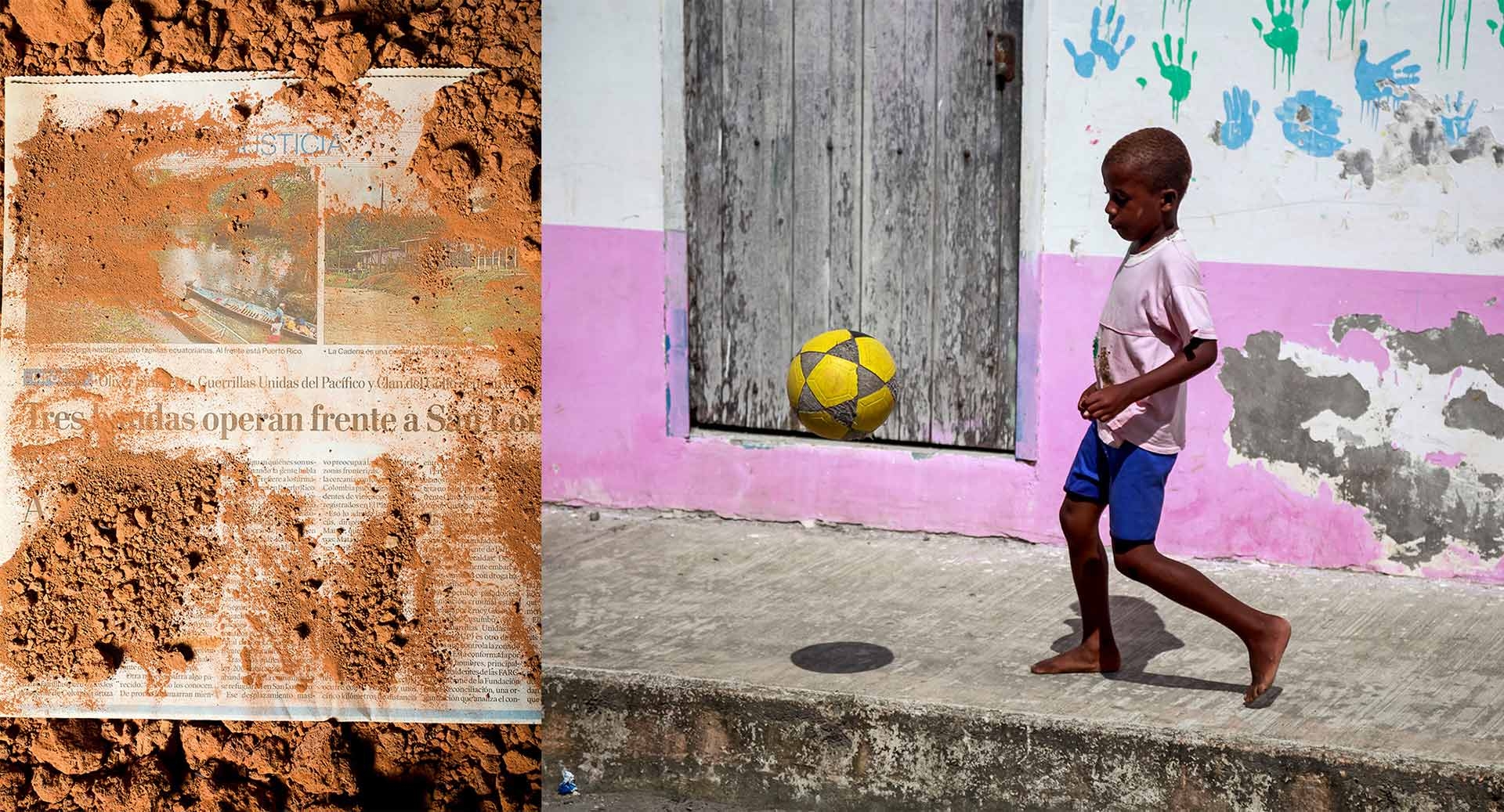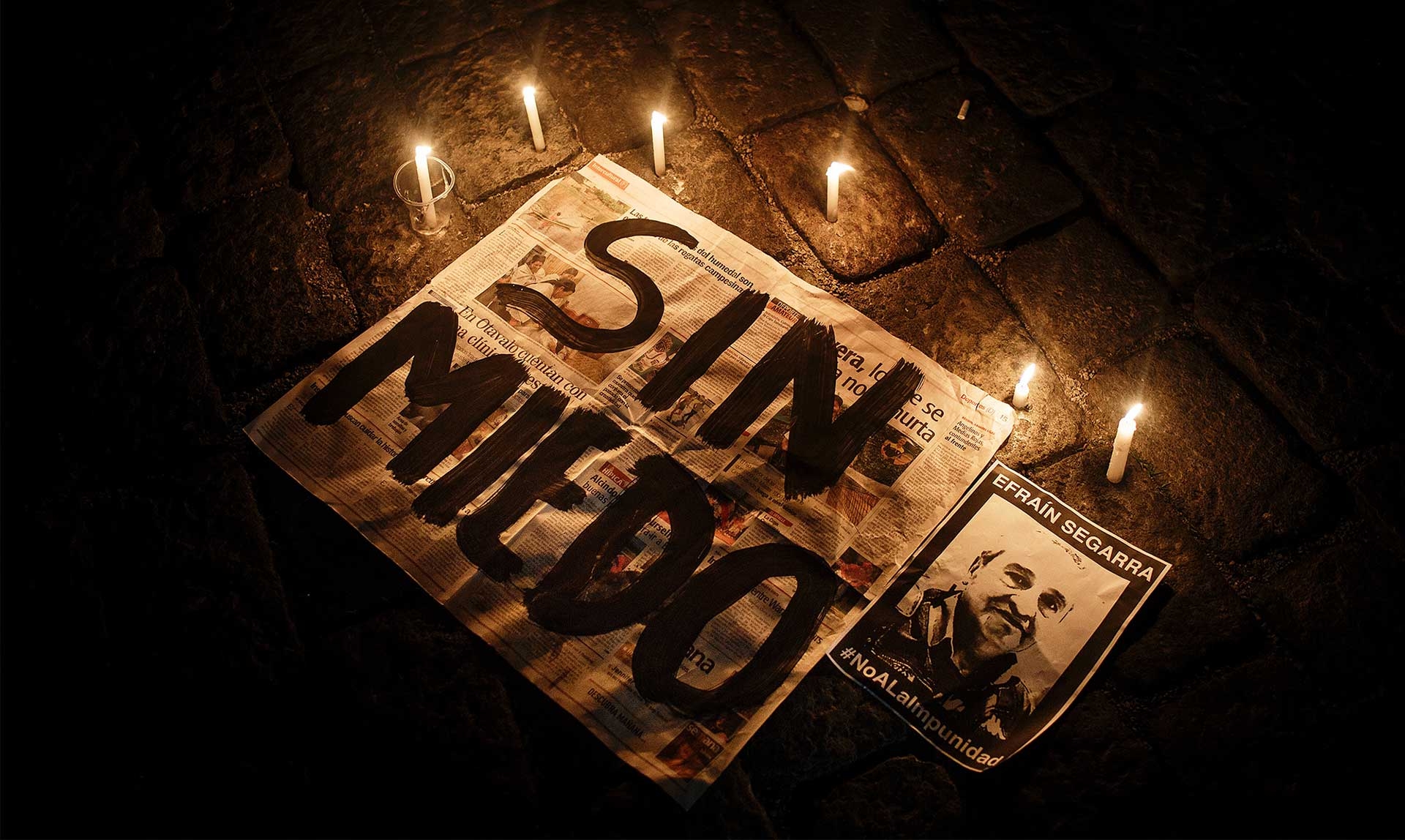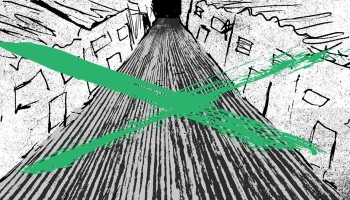The text message came at 5:02 p.m. on March 26. A man identifying himself as El Guacho, a notorious Colombian guerilla leader, said he had captured two journalists and a driver from Quito. A photo of Javier Ortega, Paúl Rivas, and Efraín Segarra from Ecuador’s El Comercio newspaper arrived 25 minutes later, with what looked like a coca field in the background.
Major Alejandro Zaldumbide of the Ecuadorian police was on the receiving end. Members of Guacho’s group had been calling and messaging him since January, demanding the release of three fellow rebels from an Ecuadorian penitentiary. Now the guerillas had leverage.
Guacho’s 300 fighters are a dominant force in drug trafficking and extortion along Colombia’s southern border with Ecuador. The faction, now known as the Oliver Sinisterra Front, split from the FARC in 2016, the year that rebel group signed a peace deal with the Colombian government.
Over six months have passed since Guacho’s men took the journalists hostage, and the Ecuadorian government has yet to give clear answers about what happened over the following 19 days. What is known is that the three men were executed and their decomposed bodies discovered two months later. The subsequent failure to catch Guacho within a 10-day deadline set by Ecuador’s President Lenin Moreno spurred both the country’s interior minister and defense minister to resign.
The tragedy illuminates a protracted crisis that no one or two officials could possibly resolve alone. The journalists’ murders took place in a region that both Ecuador and Colombia have flooded with thousands of soldiers in an attempt to quell fighting among rival drug organizations. Despite the militarization, homicides are skyrocketing. Human rights abuses have proliferated as well, hitting indigenous peoples and Afro-Latin American communities especially hard. The deaths of Ortega, Rivas, and Segarra illustrate the danger of news reporting in a lawless place, as well as the struggles of ordinary people caught in the crossfire between drug gangs and government forces (See: When Home Becomes an Armed Camp).
Their Final Farewells
The journalists’ loved ones vividly remember the men setting out on their last journey. On Sunday, March 25, they left the Ecuadorian capital of Quito for the Colombian border. Their assignment was to look into the security situation in the region following a guerilla attack on a military convoy just days before.
It wasn’t the first time the journalists had taken on such an assignment, but Yadira Aguagallo, Rivas’ partner, begged him not to go.
“Please, no, not this time … it’s too risky,” she pleaded the night before. He wasn’t even supposed to be working.
Two days prior, El Comercio had published a story about an abandoned body on the road near the Colombian border. The abdomen was badly bruised, indicating that the victim had been beaten. No one had dared retrieve the corpse because it was considered a warning from Guacho’s guerillas, just the most recent episode in a wave of violence that has shaken Ecuador’s northern border region.
The situation had become increasingly treacherous since January, when the Colombian and Ecuadorian governments began deploying 13,000 soldiers and police officers to the jungle. On Jan. 27, a car bomb exploded in front of the police station in the Ecuadorian border town of San Lorenzo. On Feb. 18, soldiers patrolling the village of El Pan were fired on. March brought bombings in three settlements. In the worst attack of all, an explosive device killed four soldiers in a military vehicle in Mataje, where Guacho’s mother had a house.
For Ecuador, the violence was unprecedented and shocking. The country had never before been hit by a car bomb.
But the journalists had made their decision. The next morning, Segarra, the newspaper’s driver, picked up Rivas and Ortega and they set off in a blue Mazda truck.
Rivas’ partner Yadira rode along as far as her mother’s house. He suggested along the way that she look for a tattoo design they could both get when he returned. Yadira thought it might have been a marriage proposal.
Ortega’s farewell to his father was unusual for them. The two had always hugged tight when the young journalist left on assignment, but this time his father was sick. “I could barely stand up. I gave him a little hug ... and he left,” he says.
Segarra, the driver, last spoke with his son Cristian two days before the trip. The newspaper had reached out to Cristian, also a journalist at El Comercio, to see if his father wanted insurance for the dangerous journey. Cristian said yes and paid for it. “I never imagined what he was going to endure,” he said. “I just said goodbye to my father like any regular day. I didn’t measure the risk.”
Into the Jungle
The journalists left Quito, taking the Pan-American Highway north toward the Colombian border and then turning west. They stopped at El Pedregal, a cheap hotel on the outskirts of San Lorenzo where some colleagues had stayed previously. The three men’s handwritten names are scrawled in the guestbook.
The team’s first objective was to get into Mataje, a hamlet on the river of the same name just a few hundred meters from the border. This was where the four soldiers had been killed. The journalists also wanted to investigate the consequences of the Ecuadorian military’s deployment to the region and to confirm reports that civilians may have been displaced.
The hotel’s security camera shows the men leaving for Mataje at 7:10 a.m. on March 26, the morning after their arrival.
Government documents show that at 9.30 a.m. the reporters passed through a military checkpoint just a kilometer from their destination. Soldiers checked their identification and let them into the restricted zone. (Authorities later said that they were warned of the dangers.)
What followed is still under investigation by Colombian prosecutors and the Inter-American Commission on Human Rights.
Two people from the area who asked not to be identified for fear of retaliation said they spoke with Mataje residents who saw what happened next. According to these accounts, the journalists parked their pickup truck and went for a walk. A man approached and spoke to the trio and they followed him across the river into Colombian territory.
“They boarded a canoe and they went to the other side,” said one of the people interviewed. “They went there without pressure, and when they got there and got deeper [into Colombian territory] ... they took them.”
Ecuadorian police Major Zaldumbide learned of the kidnapping on the same day in the text message from Guacho, the guerilla leader, whose given name is Walter Patricio Arizala Vernaza.
It later emerged that this line of communication had been opened two months earlier, leading to a series of WhatsApp messages between Zaldumbide and the guerillas. (See: The Story That Javier Ortega Never Wrote)
False Hope
The details of the journalists’ captivity remain unclear, though prosecutorial files and testimony from witnesses agree on several points: The three men were constantly relocated between small hamlets, farms, and coca fields. Some of these villages are so tiny they don’t appear on maps. The three were under continual guard by Guacho’s armed guerillas, sometimes with chains around their necks.
One witness told the Prosecutor’s Office that a top aide of Guacho (nicknamed Pitufo, or “The Smurf”) arranged guards for the prisoners. Their first stop was the Colombian hamlet of Mata de Platano. Then it was on to Brisas de Mataje, where they stayed for two days. They were then marched to an unidentified location where the group took a pair of four-wheel-drive trucks to another small town called La Mina.
Meanwhile, the Ecuadorian government was taking action. The authorities had set up a crisis committee in Quito that included Interior Minister Cesar Navas, Defense Minister Patricio Zambrano, the attorney general, the national ombudsman, representatives of the armed forces, the National Police, along with relatives and colleagues of the kidnapped men.
Within days, someone on the committee thought they had a break in the case: The journalists might be released. For five hours on March 28, an Ecuadorian prosecutor waited at the naval base in San Lorenzo expecting to retrieve the kidnapped El Comercio staff. A military helicopter stood by to fly them to safety.
At about 7 p.m., the Colombian newspaper El Tiempo reported that the guerillas had let two of the three hostages go under pressure from the Ecuadorian and Colombian militaries. Outside the Carondelet Presidential Palace in Quito, the journalists’ friends and supporters embraced with joy.
“We all shouted. It was a few seconds of indescribable happiness,” said Geovanny Tipanluisa, an editor at El Comercio.
But Colombian authorities remained almost silent. Minutes after the El Tiempo story was published, newsrooms were informed that the defense ministry would hold a press conference the next day. It was canceled without explanation. Instead, Ecuadorian Interior Minister Navas gave a brief statement, saying that efforts to free the men were ongoing and describing news reports of their liberation as irresponsible.
The three men had never arrived in San Lorenzo.
Jhon Torres, an El Tiempo editor, stands by the newspaper’s decision to publish, saying its source was of "very high credibility" and had proven to be accurate on “many, many” occasions.
Much later, long after the ordeal was over and the El Comercio men were dead, one Ecuadorian journalist received a copy of a text message allegedly exchanged between members of the armed forces.
It said the Ecuadorian military had expected the men to be released a kilometer from Mataje. They were to be taken to a naval infantry roadblock, then to an intersection between Mataje and San Lorenzo. “Keep the line [open], I have my people inside,” it read.
It was not to be.
Dead Men Walking
Instead, the kidnapped reporter, photographer, and driver were still being spirited around the jungle. After La Mina, they went on to several other towns before ending up in the house of one of Guacho’s guerrillas in El Azucar.
According to a witness, it was there, eight days after the kidnapping, that a woman and son affiliated with Guacho’s group recorded a “proof of life” video. It first aired in Colombia on April 3 and showed Ortega, Rivas, and Segarra with chains around their necks, each secured with a padlock. Ortega is pictured in a blue Mickey Mouse t-shirt. Beside him, Segarra, the driver, wears one that says “Let’s Just Go Away.”
Pitufo, the Guacho associate who reportedly arranged the guards, is said to have told Ortega what to say:
“Mr. President Lenin Moreno, ... our lives are in your hands,” he said, his arms around the backs of his companions. “The only thing they want is to exchange [us for] three of their detainees in Ecuador … and also the abrogation of this agreement that Ecuador and Colombia have to end terrorism.”
The government was working on it.
Major Zaldumbide kept his line of communication with the guerillas open. Then, according to an official report submitted to the Inter-American Commission on Human Rights, a more formal channel was opened by the crisis committee on March 27 (though Colonel Polibio Vinueza, head of UNASE, the Ecuadorian anti-kidnapping and extortion unit, said this didn’t happen until March 31, five days after the kidnapping).
At some point, the talks were handed over to Colonel Carlos Maldonado, a senior Interior Ministry advisor. Only then did the real negotiations begin.
On the afternoon of March 31, Guacho’s group sent a message to Maldonado: “Free my guys. If you don’t let them go, we will kill [the journalists] today,” they wrote.
“We are reviewing some legal issues about your guys to find a better solution,” the negotiator answered.
An Impossible Negotiation
By 9:00 p.m. that night, interior ministry and UNASE officials were at the facility near Quito where the men Guacho wanted freed were being held. They recorded two videos of one of the rebels that they later sent to Guacho.
The Men Guacho Wanted
The Ecuadorian government publicly refers to the men Guacho wanted released as Patrocinio C. P. (aka Cuco), James C. A. and Diego T. V.
“I’m not a guy with a lot of time,” Guacho messaged the next day. “If you can’t [release my men], I will send you [the journalists] one by one, in a bag. Free my guys and I free your journalists.”
The government agents replied: “We’ve already talked with one of your guys and we’re on the right track.”
Officials discussed a plan to rush Guacho's men to trial. If prosecutors secured a quick sentence, President Moreno could grant the men a pardon. But that didn’t happen; the case continued through the regular procedure.
At that time, releasing them without trial wasn’t under consideration. In a press conference after the journalists’ murders, Interior Minister Navas said: “If we wanted a pardon, we had to have a sentence. We had coordination meetings with the Prosecutor’s Office and the Judiciary to apply an abbreviated method.”
Meanwhile, the messages from the jungle continued. This one arrived at 9:00 a.m. on April 7, 12 days after the kidnapping:
“When are you going to release my boys? Or I kill the journalists and tell the Interior Minister that I have him in my sights and my attacks and bombs are going to continue. Today at 3:00 [p.m.], I will send you the video of one of them dead.”
That was the last message.
With the communications channel broken and no progress on freeing Guacho’s men through the courts, Navas held a press conference on April 9, in which he said there were no ongoing negotiations. At about that time, the government was considering exchanging Guacho’s men without a trial, but by then it was too late.
A witness told the Colombian Prosecutor’s Office that the journalists were last taken to Los Cocos, a village close to the Mira River. It was there that Segarra, the driver, seemed to recognize that hope was slipping away, saying aloud that he thought they were going to be killed.
“Yes,” replied one of the assassins, a hitman who went by the name Peru. “Your government has not fulfilled the agreement.”
Ortega, 31; Rivas, 45; and Segarra, 60, were murdered, then buried in the dark on a rainy night.
Afterward
It took more than two months for forensic teams and police to find their bodies. They were discovered on June 21, after a witness helped prosecutors locate their graves. They were found in two pits rigged with explosive devices. The graves were in Los Cocos, just 20 kilometers southeast of where they were taken.
Another corpse was dumped alongside. It is thought to be Guacho’s cousin, Fernando Vernaza, who the guerillas suspected of collaborating with Ecuadorian authorities. But according to Colombia’s National Institute of Legal Medicine and Forensic Sciences, as of late September, the body has not yet been officially identified.
The exact date the journalists were killed is unknown. An April 11 press release allegedly from Guacho’s group announced their deaths.
“The Ecuadorian government and Colombian Minister didn’t want to save the lives of the three detainees,” it said. “We deeply regret the death of the two journalists and the driver.”
The authenticity of the message has never been confirmed. On April 12, a Colombian television station, RCN TV, received a picture of the bodies. On April 13, 19 days after the kidnapping, the Ecuadorian government confirmed the murders.
Juan Manuel Santos, then Colombia’s president, initially laid the entire affair at Ecuador’s doorstep, saying “These facts occurred in Ecuador. They were kidnapped in Ecuador, by an individual with Ecuadorian nationality.” Two days later, he said they had in fact been murdered in Colombia.
It’s just that kind of inconsistency that has the slain journalists’ friends, colleagues, and family members pushing for a more thorough airing of the facts.
“There has been no justice,” the journalists’ families said in a joint Oct. 13 statement. “The pain that this atrocious crime has caused now gives us the strength to keep fighting. We have been missing three people for 183 days, and in their memory, we shout: ‘no to impunity.’”
Yadira Aguagallo, Rivas' partner, also wonders why a potentially important clue was never fully pursued. Eight days after the kidnapping, she and an El Comercio journalist received an email with two pictures. The first showed a brief handwritten message from Rivas; the second depicted the three kidnapped men. There was video, too.
Investigators analyzed the email and identified the sender’s IP address, but it’s not clear where the trail went from there, whether it led to any useful intelligence, or whether the authorities acted on it.
On April 27, Ecuadorian Interior Minister Navas and Defense Minister Zambrano resigned. Both men were members of the crisis committee charged with handling the kidnapping.
Navas didn’t respond to interview requests. Colonel Maldonado, the man who handled much of the direct communication with Guacho, declined to be interviewed.
When the Colombian Prosecutor’s Office asked for a report about any military operations that may have been carried out at the time of the kidnappings and killings, the country’s defense ministry did not respond, the Colombian newspaper El Espectador reported in July.
Not even the Colombian Prosecutor's Office has access to this material, said Pedro Vaca, executive director of the Foundation for Freedom of the Press and the families’ representative in Colombia. He called the secrecy "strange” and “inexplicable.”
Both during and after the crisis, the victims’ families were troubled by various imprecise and inconsistent statements from their main government contacts, Interior Minister Navas and Defense Minister Zambrano. For example, Rivas’s partner says that his brother, Ricardo, spoke with Navas after the false March 28 report that two of the captives had been released. Navas told him that he knew nothing other than what had been reported in the Colombian media, Aguagallo says.
But in an interview two months later, Navas said that he had learned of the reported release from intelligence officials and that Ecuador had exchanged information with Colombia. “The news comes out that [the journalists] had been freed and we didn’t know anything,” he said in the same interview. “[Colombia’s] Defense Minister called us to congratulate us on the liberation. ... Guacho never wrote us about the supposed liberation. On the contrary, he kept pressuring [us] with messages.”
These discrepancies have never been resolved.
The Arrests
On July 7, Jesus Vargas Cuagiboy, a top Guacho associate who also goes by Reinel, was arrested in connection with the journalists’ disappearance. Testimony gathered by the Colombian Prosecutor's Office indicates that the hostages were turned over to the former FARC member at some point during their captivity. He has since been indicted for aggravated kidnapping and aggravated conspiracy. He has denied the charges, though he admits that he was part of Guacho’s group.
A witness said the hostages were in Vargas’ custody after he temporarily replaced Pitufo, who had been in an accident. Carlos Viveros, Vargas’ lawyer, denies this: “He was never really with the journalists, but he did know that they had them in another unit. They connect him [with the case] because apparently [the journalists] stayed overnight in a house that belonged to his parents. In fact, the house was abandoned.”
Also in July, Gustavo Angulo Arboleda, known as Cherry, was arrested near the Pacific port city of Tumaco, Colombia, close to the Ecuadorian border. At his indictment, prosecutors said that he led the Oliver Sinisterra Front’s kidnapping gang and participated in the three men’s abduction.
Prosecutors allege that Cherry took charge of the journalists after two other members of the group – Jesus Segura Arroyo (known as Roberto) and a man who went by the name Cristian – stopped them in Mataje, and gave the order “to keep them and pass them to Colombia.” Cherry has denied all the accusations. Though his lawyer agreed to be interviewed twice, he then canceled and stopped responding to attempts to contact him.
Cherry is also accused of participating in the kidnapping of two other Ecuadorians – Oscar Villacís and Katty Velasco – who were murdered by Guacho’s group this year.
Roberto, one of the two men who allegedly stopped the reporters in Mataje, was arrested in August in Colombia’s Nariño province. According to intelligence sources, he lured the journalists to Colombia “through deception.” Roberto remains incarcerated, but has not yet been arraigned.
On Sept. 15, newly elected Colombian President Ivan Duque announced that Guacho had been wounded in a military operation. Still, the notorious narco escaped. Three days later, General Alberto Mejia, commander of Colombia’s military forces, declined to confirm or deny the news.
Correction, October 25, 2018: The story has been corrected to reflect that it was Ricardo Rivas, the brother of murdered journalist Paul Rivas, who was told by Interior Minister Cesar Navas that he had learned of the false report of the journalists' release through the Colombian media.
